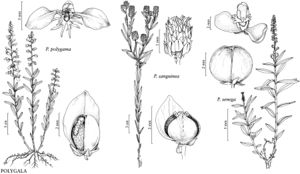Polygala senega
Sp. Pl. 2: 704. 1753.
Herbs perennial, usually multi-stemmed, (1–) 1.5–5 dm, unbranched or sparsely branched distally; from thickened caudex. Stems erect, puberulent or glabrous, hairs appressed, incurved, and spreading. Leaves alternate; subsessile or petiolate, petiole to 0.5–5 mm; blade scalelike proximally, linear-lanceolate to lanceolate-elliptic, lanceolate, or lanceolate-ovate distally, (13–) 20–80 × (1.5–) 8–35 mm, base acute, margins often appearing serrulate from toothlike projections associated with cilia, apex acute to acuminate, surfaces glabrous. Racemes conic or cylindric-conic, (1–) 1.5–4 (–4.5) × 0.5–0.9 cm; peduncle 1–3 cm; bracts deciduous, ovate. Pedicels 0.5 (–1) mm, glabrous. Flowers white, wings often with greenish veins, other sepals sometimes white, 2–4 mm; sepals ovate or lanceolate, 1–2 mm; wings suborbiculate to broadly elliptic or obovate, 2–3.7 × 2–3 mm, apex bluntly rounded (or rarely obtuse); keel 2–3.5 mm, crest 2-parted, with 2–4 lobes on each side. Capsules subglobose or ovoid, 2.5–4.5 × 3–4.3 mm, margins not winged. Seeds 2–3.5 mm, sparsely pubescent; aril 1.9–3.6 mm, lobes subequal to longer than length of seed. 2n = 34.
Phenology: Flowering spring–mid summer.
Habitat: Open woods, mesic forests, prairies, rocky creek bottoms, often on soils derived from limestone or mafic rocks, roadsides, clearings.
Elevation: 50–800 m.
Distribution
Alta., B.C., Man., N.B., Ont., Que., Sask., Ark., Conn., Del., D.C., Ga., Ill., Ind., Iowa, Kans., Ky., Maine, Md., Mass., Mich., Minn., Mo., Nebr., N.J., N.Y., N.C., N.Dak., Ohio, Okla., Pa., R.I., S.C., S.Dak., Tenn., Vt., Va., W.Va., Wis., Wyo.
Discussion
Two varieties have been recognized within Polygala senega: var. latifolia (= P. lonchophylla) with the distal leaf blades more than 1 cm wide (in correlation with an overall more robust habit and slightly larger size of most parts), and var. senega, with the distal leaf blades to 1 cm wide. A. E. Trauth-Nare and R. F. C. Naczi (1998) suggested that these entities may warrant specific recognition based on size and phenology differences, but in the absence of published details, the ranges and morphological features overlap too extensively to warrant taxonomic recognition.
Manitoba and Saskatchewan have been the major source of wild harvested roots of Polygala senega in North America, with up to several thousand kilograms being harvested annually (C. J. Briggs 1988). An increase in demand for Polygala senega has raised concerns about sustainable harvest (C. L. Turcotte 1997).
Selected References
None.
